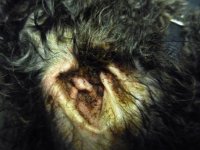Otitis Externa is a term used to describe an infection of the external (outer) ear canal. The ear is made up of three parts, the inner, middle and outer ear consisting of the vertical and horizontal ear canal.
The vertical canal of the ear is corrugated along its length. At the base of the vertical canal is a right-angled turn where the canal becomes narrower and continues horizontally to the ear drum. The ear drum separates the middle ear from the outer ear. Wax and other substances are continually produced along the entire length of the canal to keep the lining healthy.
Otitis externa can be caused by mites, allergies, yeasts or bacteria. Ear infections can be particularly unpleasant for your pet as the canal is extremely sensitive. Any irritation or wax which occurs due to the infection will cause your pet to scratch at their ear(s) and shake their head trying to dislodge the discomfort. This often causes inflammation and there may be a discharge seen which can be foul smelling. Constant head shaking may even cause an aural haematoma to develop.
Some dogs may be more susceptible than others:
- Floppy eared dogs have limited airflow in the canal creating the ideal environment for bacteria
- Especially hairy ear canals trap dirt and bacteria
- Swimming due to the microorganisms in ponds can cause ear infections
- Skin allergies will also often cause ear infections
Your veterinary surgeon will always recommend that a thorough examination of the ear canal is performed using an otoscope before any medication is prescribed. This is to ensure that the ear drum is intact and to ensure that there are no foreign bodies for example grass seeds which may penetrate further in. If ear drops are applied and the ear drum has ruptured due to the infection, loss of hearing or neurological problems including loss of balance can occur.
Once an examination has been performed, depending on the cause, your veterinary surgeon will prescribe the best course of treatment only available from your veterinary surgeon

Sometimes a swab of the infection will be taken and sent to an external laboratory for analysis. This is to determine the type of bacteria or yeast causing the problem and which treatment they will best respond to.
If your pet is prone to ear infections or you wish to prevent them from suffering from one, there are some measures you can take at home.
If the canals are especially hairy, regular plucking to remove any clumps of hair can allow better ventilation. Your vet will advise you if this is suitable for your pet.
Regular ear cleaning using a recommended product will dislodge any waxy debris from the base of the canal, bringing it to the surface allowing it to be wiped clean with some cotton wool.
This should be done regularly to prevent ear infections from occurring.
Never poke anything down the ear canal-especially cotton buds as this may cause damage.
Persistent ear infections which cause chronic thickening of the ear canal can sometimes only be resolved by surgery. The external ear canal is removed and this is called a lateral wall resection. A total ear canal ablation is performed in exceptionally severe cases which is removal of the entire ear canal.
Click on the videos below to see how to apply ear cleaner and medication as well as what ear mites look like in your pet's ear canals!




